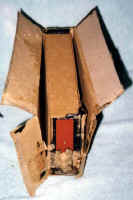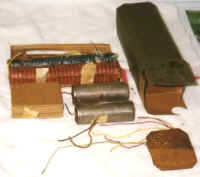| I soaked them in water which loosened up the bottom paper
cover and removed it. Then I carefully sliced down the seam in the outer wrapper and
removed it. I then cut off the top of the zinc casing with the negative terminal still
intact. A segment of 2 inch PVC pipe was cut to approximately 6 inches. Wooden plugs were
then cut to fit the inside of the pipe. In one of these plugs a hole was drilled and a
brass screw inserted and held in place with a small block of wood. This would serve as the
Positive terminal as the screw on the carbon rod is not long enough. This plug was painted
black as in some cases the paper top cover gets destroyed in the dismantling process. The
wooden plugs were then glued in place. I used a product called RC 56 which is designed to
glue anything to anything. It works well when gluing plastic parts to wooden parts.
Several
layers of newspaper were then cut and wrapped around the PVC pipe to bring it up to the
diameter of the zinc casing and were glued in place with Elmers white Glue. Once this was
glued in place, the outer cover was glued on and the bottom cover was glued in place,
again with Elmers white glue. The screw on terminals were then put back on and we have a
corrosion proof replacement, which makes an excellent display item. There is room inside
the PVC pipe for the installation of some D Cells for those who want the battery to
provide power.
The next batteries that I tackled were the BA 48, the BA 279/U and the BA 270/U. The BA
48 provided power for the receiver portion of the SCR 694 and also provided power for the
WW II O.S.S. receiver and transmitter, the SSTR 5. The latter two batteries power the
AN/PRC 6 and AN/PRC 10 radios. These provide 1.5 volts for tube filaments and B + voltages
ranging from 67 1/2, to 90 and to 135 volts. If left alone for several years corrosion
results and they too begin to leak and destroy the outer case. These batteries are made up
of four D type cells and numerous smaller cells for the B + voltages. Once again, it is
the A cells which are zinc-carbon batteries which corrode.
I opened up the outer cardboard case and removed the batteries from the case. There is
usually some black gummy stuff which oozes and makes removal difficult. I had to open all
the seams and pry the outer cover off. Then I glued the outer cover back together part
way.
I then made a wooden frame which would fill up the inside of the the case. There were
several styles of top sections but having rebuilt three of them, I found two that were
straight forward and only needed a rectangular frame. The third required a spacer on top.
The original socket is mounted to a fibre board strip and there are four leads to the
battery packs. These should be cut off with the leads as long as possible. A hole was then
drilled in the top to allow the socket a place to rest. Smaller holes were drilled for the
connecting wires. The leads from the original socket were then fed through the smaller
holes. The fibre board strip was then fastened to the wooden frame. Staples or glue can be
used. Then the entire frame was then re inserted in the case and the case glued back
together. This is adequate for a display item to sit on the shelf.
For those who must have a working battery, there is plenty of room inside for whatever
you choose to put in there. I found that it will hold three Radio Shack D cell holders
costing 99 cents each. I wove the lead in wires through the holes in the holders which
serves to hold them together. These leads were then joined and soldered to the lead in
wires from the socket connection. Joints were covered with heat shrink tubing. A small
wooden strip was then glued in to hold them in place and keep them from shifting around
inside. This serves as the filament supply. While it will not last as long as the original
battery pack, it will provide a reasonable amount of usage.
The B supply for the BA 48 was made up from ten 9 volt transistor batteries. The BA
279/U requires fifteen of the 9 volt cells. The battery snaps were bought from Radio Shack
in packs of 5 each. They were soldered together and then soldered to the socket lead in
wires.
I left the leads at their full length for ease in handling. I would recommend that they
be made shorter when you try this. The ten 9 volt batteries are held in a pack by several
wraps of electrical tape. The connection of the clip leads were covered with heat shrink
tubing. This pack is placed at the other end of the framework and held in place by small
strips of wood, keeping in mind that you will have to replace them. Since the B batteries
will last longer than the A cells, rechargeable nicads can be used for the A battery pack
and can be recharged with out opening the case.
The entire assembly is then slid back into the outer card stock casing. In this case,
you will want to be able to gain access to them so the bottom cover was held in place by
two straps of sticky Velcro obtainable from most craft stores.
A more sophisticated system can be made using an inverter power supply developed by
Dennis Starks for this purpose. In this case, the frame is made about 1/4 inch too thin
and a wooden side panel is glued in place. this serves as a place to mount the circuit
boards and keep then from bumping into each other and shorting out, etc. This system was
designed to operate from re-chargeable gel cells. While it is a bit more difficult to
construct, in the long run it will save on the cost of replacing the 9 Volt transistor
batteries.
The BA 270/U presents the most difficult challenge as the unit is not a square but has
sloping sides. It also requires a C voltage of 4.5 volts. A wooden bottom was made , a top
panel with the sides cut to the slope of the original battery and two end panels were cut
and glued together. A hole was cut in the end panel for the power socket. The interior of
this battery pack has much less space than the others. In this one the space allows for
the B battery pack but the A supply was C cells. C Cell holders are available from Radio
Shack. |












